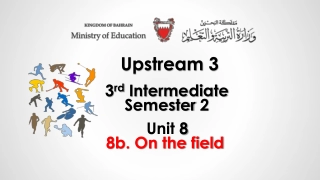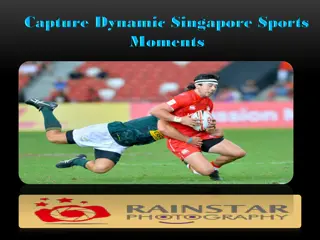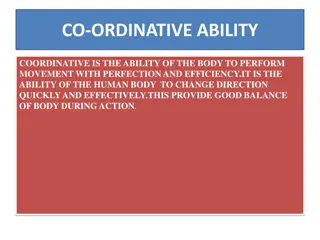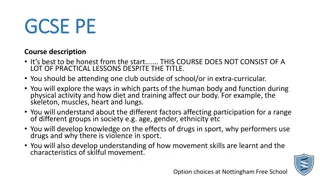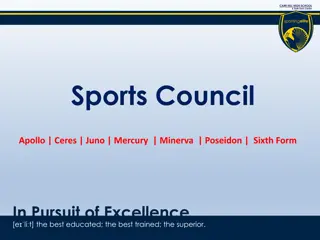Understanding the Importance of Coordinative Abilities in Sports
Coordinative ability is crucial in sports for performing movements with precision and efficiency. It involves the body's capability to change direction swiftly, ensuring good balance during actions. This ability comprises various types such as orientation, reaction, rhythm, balance, adaptation, coupling, and differentiation. Orientation ability enables athletes to analyze and adjust body positions in relation to performance areas or moving objects. Reaction ability allows quick responses to stimuli, including simple and complex reactions. Balance ability maintains body equilibrium in static and dynamic situations, particularly vital for movements in confined spaces. Rhythm ability facilitates executing movements in sync with required rhythm. Developing these abilities is key to enhancing athletic performance.
Download Presentation

Please find below an Image/Link to download the presentation.
The content on the website is provided AS IS for your information and personal use only. It may not be sold, licensed, or shared on other websites without obtaining consent from the author. Download presentation by click this link. If you encounter any issues during the download, it is possible that the publisher has removed the file from their server.
E N D
Presentation Transcript
CO-ORDINATIVE ABILITY COORDINATIVE IS THE ABILITY OF THE BODY TO PERFORM MOVEMENT WITH PERFECTION AND EFFICIENCY.IT IS THE ABILITY OF THE HUMAN BODY TO CHANGE DIRECTION QUICKLY AND EFFECTIVELY.THIS PROVIDE GOOD BALANCE OF BODY DURING ACTION.
TYPES OF COORDINATIVE ABILITY ORIENTATION ABILITY REACTION ABILITY RHYTHM ABILITY BALANCE ABILITY ADAPTATION ABILITY COUPLING ABILITY DIFFERENTIATION ABILITY
ORIENTATION ABILITY IT IS THE ABILITY OF A SPORTSPERSON TO ANALYZE AND CHANGE THE POSITION OF THE BODY AND ITS PARTS IN TIME AND SPACE IN REALATION TO PERFORMANCE AREA (e.g. play field ,gymnastic apparatus , boxing ring etc. )or a moving object (e.g ball, opponent , partner). This ability depends upon the functional capacity of optic sense organ, vestibular apparatus and kinaesthetic receptors.
REACTION ABILITY It is the ability of a sportsperson to repond quickly to a given stimulus and execute well- directed actions following a signal. It depends upon the functional capacity of optic acoustic and tactile sense organs . Generally there are two types of reaction ability- A) SIMPLE REACTION ABILITY- It is the ability to react immediately or quickly in already determined manner to a well known signal.
CONTINUE For example the reaction of a runner in the start of sprint races is already known to the runner. B) COMPLEX REACTION ABILITY- It is the ability to react immediately or quickly and accurately to undermined or unexpected signals. These signal are unexpected for sportsperson because he/ she does not know when and to which signal he/she has to react such as facing the ball in cricket by a batsman and tackling opponents in football or basketball.
BALANCE ABILITY It is the ability of a sportsperson to maintain equilibrium of the body both in static and dynamic conditions. All types of body movements are affected by this ability but it has a special importance when movements are done in a small area. This ability depends upon the functional capacity sense organs.
RHYTHM ABILITY It is the ability of the sportsperson to understand the rhythm of movement and to execute the movement with required rhythm. It depends upon the functional capacity of optic, acoustic and kinaesthetic sense organs.
COUPLING ABILITY Coupling ability is the ability to combine the movements of different body parts for performing perfect sports movements. This ability is very significant for approximately all sports but specially in team games, gymnastics and combative sports (boxing, wrestling, etc.). For example, in boxing, the movements of hands, head, trunk and feet are essential to couple to achieve a certain goal.
ADAPTATION ABILITY It is the ability of a sportsperson to bring about an effective change in the movement according to anticipated changes in situation. It depends upon the functional capacity of optic and acoustic sense organs.
DIFFERENTIATION ABILITY Differentiation ability is the ability to achieve a high degree of accuracy and economy of separate body movements and movement phases in a motor action. The high level of this ability depends on experienced movement and the degree of mastery over motor action.


